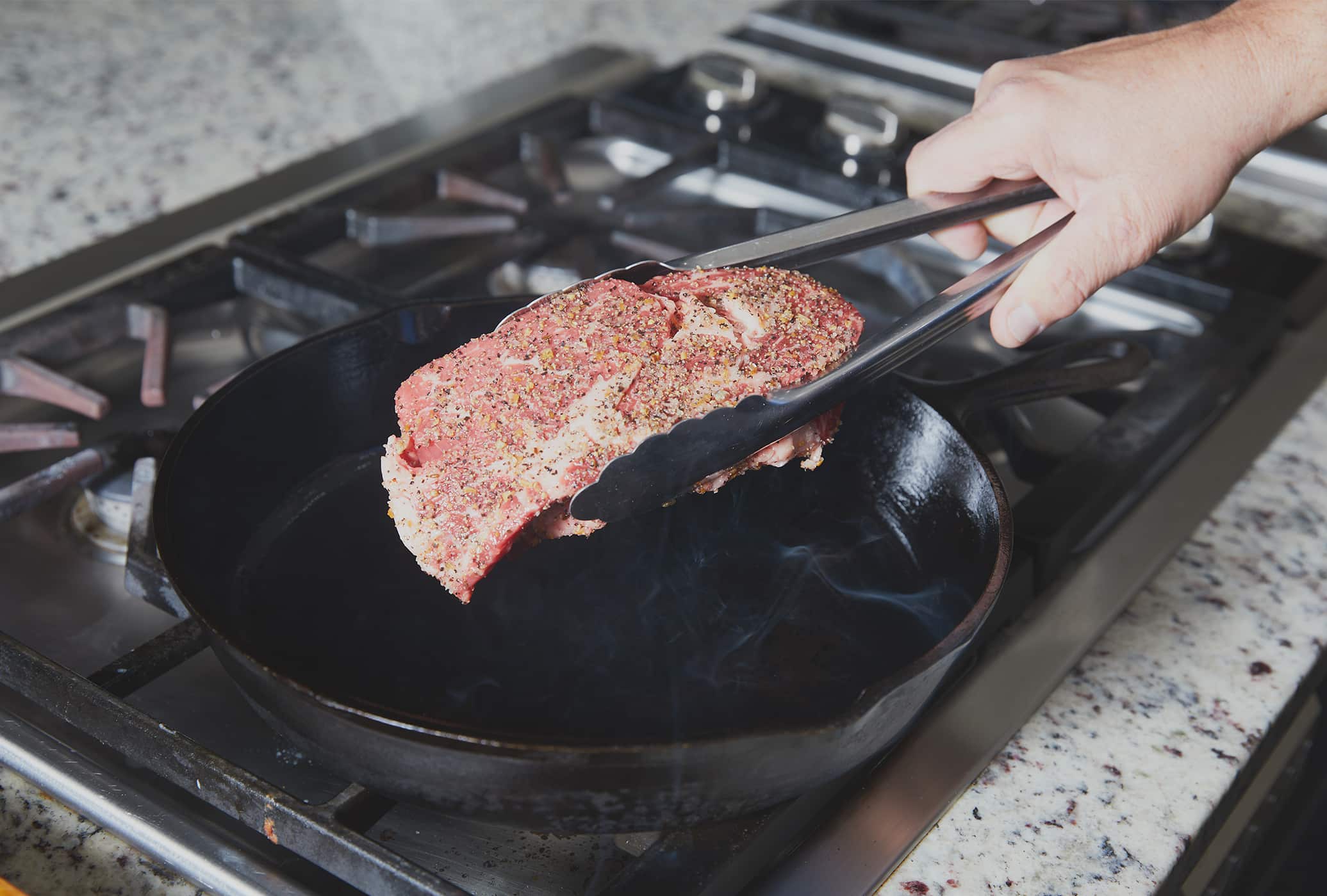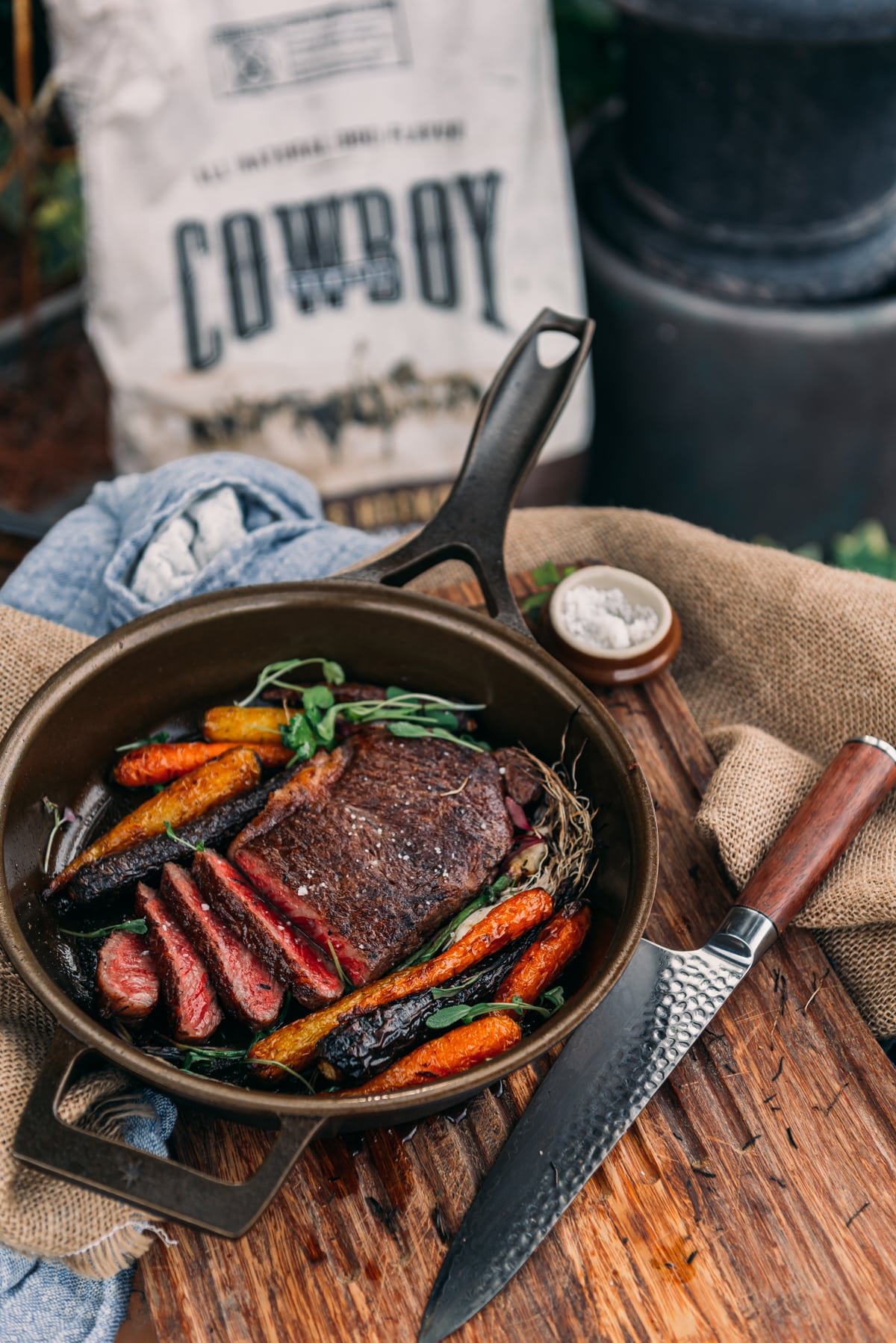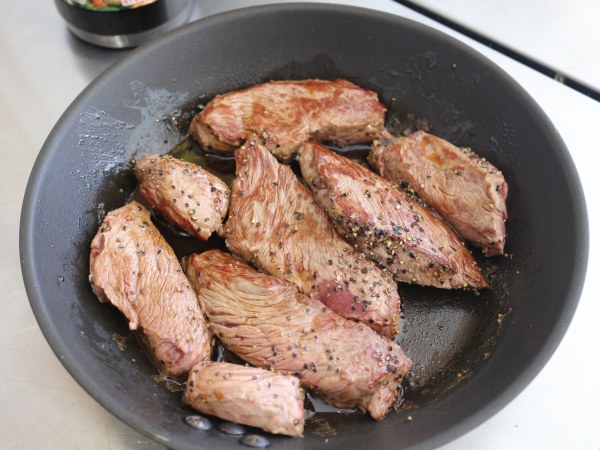
Getting to Know Pan-Searing
What is Pan-Searing?
Pan-searing is cooking food quickly over high heat in a hot pan with just a bit of oil. This technique helps you get a nice browned crust on your meat while sealing in those tasty juices. If you love steak, you’ll appreciate the fantastic caramelization that boosts flavor and looks great.
Why Pan-Searing Steaks is Awesome
Pan-searing is a popular way to cook steaks for a bunch of reasons:
- Brings Out Flavor: The high heat creates those tasty Maillard reactions that give steaks rich flavors.
- Keeps it Juicy: Searing locks in juices so your steak stays moist and delicious.
- Super Versatile: You can use this method with many steak cuts and adjust cooking times to your liking.
- Easy to Control: Cooking on the stovetop lets you see what’s happening and make adjustments as needed.
Next time you’re cooking, give pan-searing a try for a great mix of flavor and tenderness!

Picking the Right Steak
Finding the Best Cut of Meat
Choosing the perfect cut of steak is key for that ideal pan-sear. Each cut has its own flavors and textures, so it’s important to pick one that fits your taste and cooking style. Here are some top picks:
- Ribeye: Known for its rich marbling, ribeye is super juicy and packed with flavor.
- Filet Mignon: Loved for its tenderness, this cut is lean but has a delicate feel.
- Strip Steak: A nice combo of flavor and tenderness, making it a great choice for pan-searing.
- Sirloin: Leaner than ribeye yet still flavorful, sirloin works well as a middle-ground choice.
Trying out different cuts not only spices things up in your cooking but also helps you discover what flavors you enjoy most.
Thickness Matters for Pan-Searing
How thick your steak is really impacts how well it sears. Here’s the scoop:
- Control: Steaks at least 1 inch thick help keep the heat steady and cook evenly.
- Juiciness: Thicker cuts hold onto moisture, giving you a juicy interior while getting that nice brown crust.
- Cooking Time: Thicker steaks need a bit more time to cook through to your desired doneness.
The right blend of cut and thickness will take your steak experience to the next level!

Getting Your Steak Ready
Bringing the Steak to Room Temp
A lot of cooks swear by letting the steak sit at room temperature before cooking. While it’s common to let it sit for 30-40 minutes this might not make much difference for thicker cuts. For a 1-inch steak, it may only get to about 52°F after that time.
Rather than just timing it, focus more on technique. If you’re using a cold-start approach—starting with the steak in a pan that gradually heats—you can skip the wait altogether.
Seasoning Your Steak for Cooking
Seasoning is where the fun begins. Check out this quick guide to boost your steak’s flavor:
- Dry it Well: Moisture can mess with your sear. Use paper towels to remove excess liquid.
- Season Generously: Use kosher salt and freshly ground pepper; this helps form that tasty crust and amps up flavor.
- Timing: For the best flavor, season at least 40 minutes before cooking or right before it hits the pan.
With these steps, you’ll be on your way to impressing everyone with your steak!

Nailing the Pan-Searing Technique
Choosing the Right Pan
Picking the right pan is super important for pan-searing. A sturdy skillet, like cast iron or stainless steel, works best. Here’s why:
- Heat Retention: Cast iron holds heat really well, making cooking temperatures consistent while you sear.
- Natural Non-Stick: Stainless steel creates a natural non-stick surface when seasoned right, letting the steak release easily when it’s time to flip.
- Skip Non-Stick Pans: They can’t handle the high heat needed to get a proper sear, which is crucial for that tasty crust.
Using the right pan boosts flavor and makes cooking smoother and more enjoyable.
Finding the Ideal Searing Temperature
For that perfect sear, your pan needs to be nice and hot. Start by preheating your skillet over medium-high heat until it’s very hot. To check:
- Water Drop Test: Flick a couple of drops of water into the pan. If they sizzle and evaporate right away, your pan is ready!
Once heated, add a high-smoke-point oil, like canola or avocado oil, till it shimmers. Now you’re set for that awesome sear!

Cooking That Perfect Steak
Searing the Steak
After prepping your steak and picking the right tools, it’s time to sear! The secret is using a really hot pan. Here’s how to do it:
- Get the Pan Hot: Heat your cast iron or stainless steel skillet over medium-high heat until it’s super hot. It should sizzle immediately when you add oil.
- Add Oil: Pour in a high-smoke-point oil like canola or avocado, and wait till it shimmers. That’s when you can add the steak.
- Sear the Steak: Carefully place the steak in the pan, laying it down away from you to avoid splatter. Let it sear without touching for about 3 minutes to get that perfect crust before flipping it.
This first sear is crucial for flavor and texture. A nice crust not only tastes great but also gives your dish that professional look.
Keeping an Eye on Cooking Time
After flipping the steak, watch the cooking time closely. Here’s a quick guide:
- Cook Thickness: For a 1.5-inch steak, aim for about 3 to 4 minutes on the second side for medium-rare.
- Check Doneness: The best way to check is to use a meat thermometer. Aim for:
- Rare: 120-130°F (49-54°C)
- Medium Rare: 130-135°F (54-57°C)
Remember that the steak keeps cooking while it rests, so pull it off just below your target temp. Enjoy your meal!

Resting and Serving
Why Resting Your Steak is Key
After all that work, don’t dive into your steak right away! Resting is super important because it lets the juices move back into the meat. When cooking, the fibers tighten up and push juices toward the center. If you cut too early, you could lose all that awesome liquid.
- Resting Time: Shoot for about 5 to 10 minutes for each inch thick.
- Cover Up: Lightly drape the steak with aluminum foil to keep it warm.
This little wait pays off big: you’ll get a juicy, tender steak full of flavor!
Serving Ideas and Toppings
Now let’s make your plate look amazing! Here are some serving ideas to enhance your steak dinner:
- Sides: Go classic with roasted veggies, garlic mashed potatoes, or a fresh arugula salad.
- Sauces: Amp up flavor with sauces like béarnaise, chimichurri, or a simple red wine reduction.
- Garnishes: A sprinkle of flaky sea salt or a drizzle of herb-infused olive oil gives that gourmet feel.
With these finishing touches, your steak becomes more than just food; it’s a delightful experience. Enjoy!

Fixing Common Problems
Overcooked Steak
Overcooking steak is a big letdown. If you find this happening, here are some handy tips:
- Use a Meat Thermometer: Grab a good meat thermometer to track internal temps accurately. Pull the steak off the heat when its 5-10 degrees below where you want it.
- Carryover Cooking: Remember, your steak will keep cooking while it rests. Take it off just before reaching your desired temp for the best results.
- Look for Signs: Watch for the steak’s color and firmness. If it’s dark and stiff all over, it’s likely overdone.
Learning to judge doneness takes time, but you’ll get the hang of it soon!
Fixing Uneven Searing
Uneven searing can leave parts of the steak perfectly crusted while others look pale. Here’s how to get it right:
- Don’t Overfill the Pan: Make sure each steak has room. If too crowded, steam gets trapped, leading to uneven cooking.
- Preheat Properly: Ensure your pan’s hot enough before adding the steak. Reaching around 500°F ensures an even sear.
- Flip More Often: Think about flipping your steaks more regularly. This helps achieve an even crust all around.
With these tips, you’ll better your steak-cooking skills and enjoy more consistent results!

Playing with Flavors and Variations
Testing Out Different Seasonings and Marinades
Changing up your seasonings and marinades can take your steak to a whole new level! Check out these ideas:
- Classic Seasoning: A simple mix of salt and fresh black pepper enhances the meat’s natural taste.
- Herb Additions: Mix garlic powder, rosemary, and thyme for a fantastic aroma.
- Marinades: Try a marinade with soy sauce, garlic, and a splash of balsamic vinegar. Let the steak soak for at least an hour for a flavor boost.
Keep in mind, marinating adds flavor and can tenderize tougher cuts.
Trying Out Different Searing Techniques
Switch up your searing methods! Test these techniques for better results:
- Frequent Flipping: Instead of searing on one side then flipping, try turning the steak every 30 seconds. This gives you more even cooking and a nice crust.
- Butter Basting: Near the end of cooking, toss in butter and herbs like thyme or garlic to the pan. Spoon that melted butter over the steak for extra flavor.
With these techniques, you’re sure to find a new favorite way to cook steak!

Mastering Pan-Searing
Tips for Perfect Steaks Every Time
Getting the perfect steak every single time takes some practice and attention. Here are some reliable tips to help you:
- Room Temp: Always let your steak sit at room temperature before cooking. This leads to more even cooking and better browning.
- Season Right: Use kosher salt generously at least 40 minutes before cooking. This adds flavor and helps create that crust during searing.
- High Heat: Make sure your pan is hot enough before adding the steak. Around 500°F helps you get that perfect crust while keeping the inside tender.
I can tell you from experience that letting the steak rest after cooking makes it juicier and packed with flavor!
Leveling Up Your Pan-Searing Skills
To really perfect your pan-searing technique, try these advanced methods:
- Butter Basting: In the last minute of cooking, add butter and herbs to the pan. Spoon the melted butter over the steak for an even richer flavor.
- Frequent Flipping: Experiment with flipping your steak more often as it cooks. This technique helps to achieve that golden-brown crust all around while cutting down cooking time.
By trying these techniques, you’ll become a pro at pan-searing! Enjoy both the journey and the delicious results.

Leave a Reply